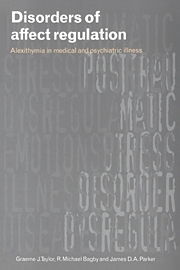Book contents
- Frontmatter
- Contents
- Foreword
- Acknowledgments
- Acknowledgment of permission for use of material
- Introduction
- 1 The development and regulation of affects
- 2 Affect dysregulation and alexithymia
- 3 Measurement and validation of the alexithymia construct
- 4 Relations between alexithymia, personality, and affects
- 5 The neurobiology of emotion, affect regulation, and alexithymia
- 6 Somatoform disorders
- 7 Anxiety and depressive disorders and a note on personality disorders
- 8 Substance use disorders
- 9 Eating disorders
- 10 Affects and alexithymia in medical illness and disease
- 11 Treatment considerations
- 12 Future directions
- Appendix
- References
- Index
5 - The neurobiology of emotion, affect regulation, and alexithymia
Published online by Cambridge University Press: 21 September 2009
- Frontmatter
- Contents
- Foreword
- Acknowledgments
- Acknowledgment of permission for use of material
- Introduction
- 1 The development and regulation of affects
- 2 Affect dysregulation and alexithymia
- 3 Measurement and validation of the alexithymia construct
- 4 Relations between alexithymia, personality, and affects
- 5 The neurobiology of emotion, affect regulation, and alexithymia
- 6 Somatoform disorders
- 7 Anxiety and depressive disorders and a note on personality disorders
- 8 Substance use disorders
- 9 Eating disorders
- 10 Affects and alexithymia in medical illness and disease
- 11 Treatment considerations
- 12 Future directions
- Appendix
- References
- Index
Summary
In recent years, several personality theorists have emphasized the influence of genetic factors on adult personality traits and the need for linking personality constructs with neurobiological processes that might underlie individual differences in personality (Buss, 1990; Eysenck, 1991a; Gray, 1994; Cloninger, Svrakic & Przybeck, 1993; Zuckerman, 1992). Given the plethora of personality constructs that have appeared in the scientific literature, and the considerable overlap among various personality models, Eysenck (1991a) and Zuckerman (1992) have suggested that the most important and meaningful personality variables for future research will be those traits that show at least moderate heritability and that can be linked to underlying anatomical, physiological, or hormonal factors.
To date (and to the best of our knowledge), there has been only one attempt to investigate the heritability of alexithymia. This was a Norwegian study in which Heiberg and Heiberg (1977) measured alexithymia with the interviewer-rated BIQ and compared the similarity of identical (monozygotic) twins with that of fraternal (dizygotic) twins. The data yielded evidence for a strong genetic effect on the alexithymia trait. As Lesser (1981) has pointed out, however, only a small number of twins were studied (33 pairs), and since the twins were raised in their own families, they were exposed to similar environmental influences.
While much more genetic research is needed, using both twin design and adoption design methods, over the past two decades there has been a growing research interest in exploring the neurobiology of alexithymia.
- Type
- Chapter
- Information
- Disorders of Affect RegulationAlexithymia in Medical and Psychiatric Illness, pp. 93 - 113Publisher: Cambridge University PressPrint publication year: 1997
- 4
- Cited by



